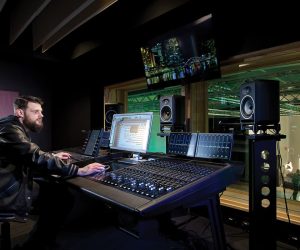
SAE Got Game
Preparing students for careers in game audio.
The Australian Council for the Arts’ recent survey on musicians’ collaboration with the digital game sector reveals the growing opportunities available to audio professionals. SAE Creative Media Institute is at the forefront of preparing audio students for success in the thriving gaming industry — with many sound design graduate roles starting at over $60k. With insights from SAE senior audio lecturer Nick Harrison and success stories from graduates Gabriel Furber and Yannis Brown, SAE stands as a leading institution for those aspiring to forge a rewarding career in game audio.
SAE senior audio lecturer, Nick Harrison explained the unique skill set that audio professionals bring to the games industry. “What’s really fascinating about coming into game sound from a music production or audio engineering perspective is the different approach and possibilities – there is the traditional approach to game sound, but the tools also open up a lot more beyond that.”
As part of SAE’s Bachelor of Audio degree Nick teaches students the skills to get sound into a game engine, while working with industry tools. “Learning how to implement sound both natively in Unity and Unreal, and FMOD and Wwise audio middleware is what the studios are looking for, which is why we spend time with students working on those platforms — they graduate from SAE with skills and knowledge that is in demand.”
During his studies, one of Nick’s former students, Gabriel Furber, picked up an audio design role in Melbourne at Infinity Plus Two. Given Gabriel’s knowledge in game audio, he was initially able to complete the work placement hours for his degree at his new employer.
“I was getting ready to do my work placement, which is when I started to look around online for different jobs, and came across this opportunity at Infinity Plus,” Gabriel said. “I’d always had a strong affection for games rather than films, so it always seemed the ideal direction for my career. Studying at SAE provided me with the foundational audio skills, and having the chance to experience a unit on game audio with Nick was extremely valuable for what I do now.”
Yannis Brown is an SAE graduate and senior lead audio designer who was involved with the Emmy-award winning Wolves in the Walls VR for Meta. Having worked in California and Washington, he’s now at Halfbrick in South Australia – made famous for Fruit Ninja, Jetpack Joyride, and Dan The Man. Yannis explained the reasons behind the increased opportunities for audio professionals in games.
“I’d say the prospects in game audio are still growing, and a lot of that is because of the sheer number of developers which are continuously forming with a rise of the Indie games scene which typically focuses on smaller teams and games. Successful Indie developers expand their product ranges and can develop into larger companies which require full time audio staff,” Yannis said. “Gaming is now the largest sector in the entertainment business. Having worked abroad, there are many opportunities around the world, so it really comes down to where your interests and passions guide your career.”
With more jobs comes increased competition, and Yannis gave some insight into how audio graduates can stand out in a crowded marketplace.
“Film is a linear media which requires linear audio design, however since a game might be played for 20 hours or more, and the player interacts with a responsive world, both repetitiveness and interactivity are key concepts around which much of the technical and creative audio design is focused on,” he said. “Coming up with creative ways of making the most of your sound budget, is what will help newcomers to the industry, and that can involve looking at the technical design of the system you’re using, and analysing the memory and channels at your disposal.”
For high school students looking to get into game audio as a future career, Nick Harrison shared how they can prepare themselves before studying at somewhere like SAE.
“Practice working with audio in a DAW, chopping it up, looping it, processing and exporting. Consider different ways that sounds in games occur — they might be triggered, or be emitting from a location with their volume and panning relative to the player’s location, or perhaps they are emitting from the player. Then start looking into game engines such as Unity and Unreal Engine. Continue to stay up to date with the changes in technology, as game audio is a rapidly evolving area, and a great way to delve into spatial audio, head tracking and XR — that will set you up for a great position in both the games and audio industries.”
















RESPONSES